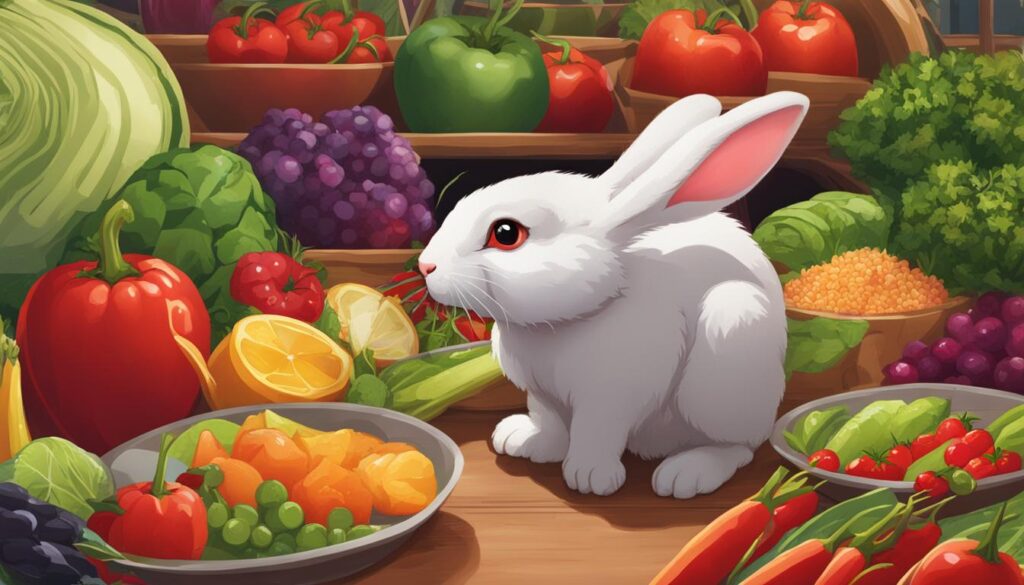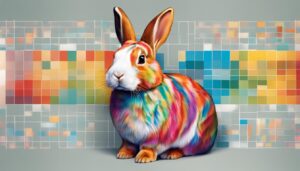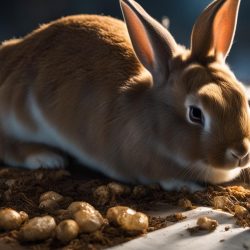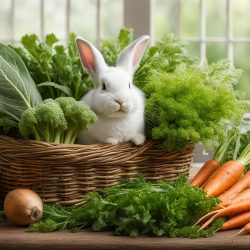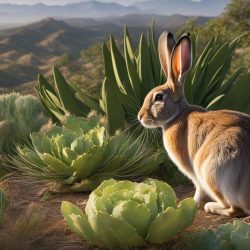Feeding rabbits the right diet is crucial for their health. It is important to understand what foods are safe and what foods should be avoided. This guide will provide essential information on what rabbits should not eat to ensure their optimal nutrition and well-being.
Key Takeaways:
- Rabbits have specific dietary requirements and need a well-balanced diet for optimal health.
- There are certain foods that are toxic or harmful to rabbits and should be avoided.
- Hay and grass should make up the majority of a rabbit’s diet, providing essential nutrients and aiding in dental health.
- Rabbits can have a small amount of vegetables, but some vegetables should be avoided.
- Pellets can be offered as a supplement, but should only make up a small portion of a rabbit’s diet.
- Consistency in a rabbit’s diet and feeding schedule is important for their well-being.
- Treats should be limited and healthy options should be chosen.
- Proper hydration is crucial for a rabbit’s health, and fresh water should always be available.
The Right Diet for Rabbits
Rabbits are herbivores and have specific dietary requirements to ensure their optimal health and well-being. A balanced diet for rabbits should primarily consist of plants, as they are naturally herbivorous animals. Their nutritional needs are similar to their wild counterparts, and they require essential nutrients to support their overall health.
When planning a rabbit’s diet, it is important to include a variety of food sources that provide the necessary nutrients. The ideal rabbit diet should consist of approximately 85% hay or grass, 10% leafy vegetables, and 5% pellets. This combination provides rabbits with the essential fiber, vitamins, and minerals they need for healthy teeth, digestion, and overall vitality.
The Importance of Essential Nutrients
Rabbits have unique dietary needs that are best met through a herbivorous diet. The high-quality fiber found in hay and grass is particularly important for rabbits as it helps wear down their continuously growing teeth and promotes a healthy digestive system. Leafy vegetables provide additional vitamins and minerals, while pellets can supplement their diet with balanced nutrition.
| Food Type | Percentage of Diet |
|---|---|
| Hay or Grass | 85% |
| Leafy Vegetables | 10% |
| Pellets | 5% |
By following these guidelines and providing a well-rounded diet, rabbit owners can ensure that their pets receive the necessary nutrients for a healthy and fulfilling life.
Hay and Grass for Rabbits
Hay and grass are essential components of a rabbit’s diet, constituting around 80% of their daily food intake. They provide a variety of benefits for rabbits, making them crucial for their overall health and well-being.
One of the primary advantages of hay and grass is that they are excellent sources of fiber. Rabbits require a high-fiber diet to maintain a healthy digestive system and prevent issues like gastrointestinal stasis. Additionally, the constant chewing on hay and grass helps to wear down their continuously growing teeth, promoting dental health and preventing dental problems.
To ensure the best nutrition for your rabbit, it is important to choose high-quality hay that is dry, sweet-smelling, and free from dust, grit, and mold. Timothy hay is a popular choice for rabbits due to its high fiber content and low calcium content. Other types of hay, such as orchard grass or meadow grass, can also be suitable options. It is recommended to provide unlimited access to hay throughout the day, allowing rabbits to graze and fulfill their natural foraging instincts.
| Benefits of Hay and Grass for Rabbits | Types of Hay Suitable for Rabbits |
|---|---|
|
|
In addition to hay, fresh grass can also be included in a rabbit’s diet. However, it is important to ensure that the grass is free from pesticides or other harmful substances. If you do not have access to safe grass, providing a variety of hay types can sufficiently meet a rabbit’s nutritional needs.
Safe Vegetables for Rabbits
Adding a small amount of vegetables to a rabbit’s diet can provide them with additional nutrients and variety. However, not all vegetables are safe for rabbits to consume. It is important to choose rabbit-safe vegetables that are low in sugar and not harmful to their digestive system. Here are some leafy greens that are safe for rabbits:
- Asparagus
- Basil
- Broccoli
- Brussels sprouts
- Carrots
- Celery leaves
- Chard
- Courgette
- Dock
- Green beans
- Romaine lettuce
- Parsley
- Radish tops
These vegetables can be given to rabbits in small quantities as part of their overall diet. It is important to introduce new vegetables gradually to avoid any digestive upset. Always wash the vegetables thoroughly and ensure they are fresh before feeding them to your rabbit.
Remember, while these vegetables are safe for most rabbits, it is always best to consult with a veterinarian for specific dietary recommendations based on your rabbit’s individual needs and any health conditions they may have.
| Veggies | Portion Size |
|---|---|
| Asparagus | 1-2 spears |
| Basil | A few leaves |
| Broccoli | About 1 floret |
| Brussels sprouts | 1-2 sprouts |
| Carrots | About 1 baby carrot or a few slices |
| Celery leaves | A few leaves |
| Chard | A small handful |
| Courgette | 1-2 slices |
| Dock | A small handful |
| Green beans | A small handful |
| Romaine lettuce | A few leaves |
| Parsley | A few sprigs |
| Radish tops | A small handful |
Foods Unsafe for Rabbits
When it comes to feeding rabbits, there are certain foods that should be avoided as they can be toxic or harmful to their health. It is important to be aware of these foods to ensure the well-being of your furry friend.
Toxic Foods for Rabbits
- Avocado: Avocados contain a substance called persin, which is toxic to rabbits and can cause digestive issues.
- Onions: Onions, along with garlic and shallots, are known to cause anemia in rabbits when consumed in large quantities.
- Peas: While small amounts of peas may not be harmful, excessive consumption can lead to gas and digestive problems in rabbits.
- Chocolate: Chocolate contains theobromine, which is toxic to rabbits and can cause symptoms such as rapid breathing, tremors, and seizures.
- Nuts: Nuts, especially almonds and peanuts, should be avoided as they can cause blockages in a rabbit’s digestive system.
Other Dangerous Foods for Rabbits
- Iceberg Lettuce: Iceberg lettuce has a high water content and lacks nutritional value, and it can also cause diarrhea in rabbits when consumed in large quantities.
- Parsnips: Parsnips contain high levels of sugar and can cause digestive issues and weight gain in rabbits.
- Rhubarb: Rhubarb leaves are toxic to rabbits and can cause severe kidney damage if ingested.
- Garlic: Garlic, like onions, can cause anemia in rabbits and should be avoided.
- Meat, Eggs, and Dairy Products: Rabbits are strictly herbivorous and cannot digest animal proteins, so it’s important to avoid feeding them meat, eggs, and dairy products.
In conclusion, it is crucial to be mindful of what foods you feed your rabbit. Avoiding toxic and dangerous foods will help ensure their health and well-being. Stick to a balanced diet of hay, grass, vegetables, and pellets, and consult with a veterinarian for personalized advice on your rabbit’s dietary needs.
| Foods Unsafe for Rabbits | Effects on Rabbits |
|---|---|
| Avocado | Toxicity, digestive issues |
| Onions | Anemia |
| Peas | Gas, digestive problems |
| Chocolate | Theobromine toxicity: rapid breathing, tremors, seizures |
| Nuts | Digestive blockages |
| Iceberg Lettuce | Diarrhea, lack of nutritional value |
| Parsnips | Digestive issues, weight gain |
| Rhubarb | Kidney damage (leaves) |
| Garlic | Anemia |
| Meat, Eggs, and Dairy Products | Inability to digest animal proteins |
Pellets in a Rabbit’s Diet
While hay and vegetables form the majority of a rabbit’s diet, pellets can be offered as a supplement to provide a balanced nutrition. It is important to note that pellets should only make up about 5% of a rabbit’s overall diet.
When choosing pellets for your rabbit, opt for high-quality options instead of muesli-style foods. Muesli can encourage selective feeding, where rabbits pick out their favorite pieces and ignore the rest, leading to nutritional imbalances. Look for pellets that are specifically formulated for rabbits, containing a mix of fiber, protein, and essential nutrients.
To properly feed pellets to your rabbit, measure out the recommended portion size based on their weight, age, and activity level. It is crucial not to overfeed pellets, as this can lead to obesity and associated health issues. Additionally, always provide fresh hay and water alongside the pellets to ensure your rabbit’s diet remains well-balanced and hydrating. Consult with a veterinarian for tailored advice on feeding pellets to your rabbit based on their individual needs.
| Pellets in a Rabbit’s Diet | Portion Size | Feeding Frequency |
|---|---|---|
| Hay | 85% of diet | Unlimited access |
| Vegetables | 10% of diet | Divide into morning and evening meals |
| Pellets | 5% of diet | Measure recommended portion size |
Maintaining a Rabbit’s Diet: Consistency and Changes
Consistency in feeding rabbits is key to ensuring their optimal health and well-being. Unlike dogs and cats, a rabbit’s nutritional needs do not change as they age. From an early age, rabbits should be fed a consistent diet of hay, grass, vegetables, and pellets to meet their dietary requirements. This helps maintain their digestive system and promotes a healthy eating pattern.
However, as rabbits enter their later years and become less active, their food intake may need to be adjusted. They may require less food to maintain a healthy weight. It is recommended to consult with a veterinarian for tailored advice on a rabbit’s diet based on their age, lifestyle, and any existing health conditions. Veterinarians can provide guidance on modifying portion sizes and adjusting the composition of the diet to meet the specific needs of individual rabbits.
Changes in a rabbit’s diet should be made gradually to avoid digestive upset and ensure a smooth transition. Any changes to their diet should be introduced slowly over a period of several days, gradually increasing the new food while reducing the previous food. This helps rabbits adapt to the new diet without causing any stress on their digestive system.
Table: Recommended Changes in a Rabbit’s Diet
| Age | Change in Diet |
|---|---|
| Young | No significant changes required |
| Adult | Maintain consistent diet |
| Elderly | Consult with a veterinarian for personalized advice |
By maintaining a consistent diet and making gradual changes when necessary, rabbit owners can ensure their furry companions receive the proper nutrition they need to thrive. A healthy and balanced diet, tailored to a rabbit’s individual needs, is key to promoting their overall well-being and longevity.
Feeding Quantity for Rabbits
Feeding rabbits the right quantity of food is essential for maintaining their health and well-being. The amount of food a rabbit should eat depends on factors such as breed, age, and size. It’s important to provide them with a balanced diet while ensuring they are not underfed or overfed. Here are some general feeding guidelines for rabbits:
Hay and Grass:
Hay and grass should make up the majority of a rabbit’s diet, around 80%. They should have unlimited access to hay to maintain their dental health and digestive system. The recommended portion of hay is approximately the size of their body or a pile that is equal to the size of their enclosure.
Vegetables:
Rabbits can have a small amount of vegetables in their diet, around 15%. The recommended portion is about one packed cup of fresh, leafy greens per two pounds of body weight. It is important to introduce new vegetables gradually to prevent digestive upset.
Pellets:
Pellets can be offered as a supplement to a rabbit’s diet, accounting for about 5% of their daily intake. The recommended portion size is approximately one to two tablespoons per five pounds of body weight. It’s crucial to choose high-quality pellets that are specifically formulated for rabbits.
Monitoring and Adjustments:
Monitoring a rabbit’s weight and body condition is crucial in determining if they are getting the right amount of food. Signs of an underfed rabbit include weight loss, lethargy, and decreased appetite, while an overweight rabbit may have difficulty grooming or moving around. Adjustments to their diet can be made accordingly to maintain a healthy weight.
Remember that these are general guidelines, and it’s important to consult with a veterinarian for personalized advice based on your rabbit’s specific needs and circumstances.
| Food Type | Portion Size |
|---|---|
| Hay | Unlimited access, approximately the size of their body or a pile equal to the size of their enclosure |
| Vegetables | One packed cup of fresh, leafy greens per two pounds of body weight |
| Pellets | One to two tablespoons per five pounds of body weight |
Feeding Frequency for Rabbits
Establishing a proper feeding schedule for rabbits is essential for their overall health and well-being. It helps ensure they receive the right amount of nutrition and prevents overfeeding or underfeeding. Mealtime consistency is key, as rabbits thrive on routine and can become stressed or anxious with sudden changes in their feeding schedule.
So, how often should you feed your rabbits? Ideally, rabbits should have access to hay and fresh water at all times. However, when it comes to vegetables and pellets, it is recommended to divide their meals into two servings per day. This allows for proper digestion and gives you the opportunity to monitor their appetite and check on their health.
When establishing a feeding schedule, it is important to note that each rabbit is unique, and their dietary needs may vary. Factors such as age, breed, and activity level can influence the amount and frequency of their meals. Consulting with a veterinarian can help you determine the appropriate feeding schedule for your specific rabbit.
Sample Feeding Schedule for Rabbits
| Mealtime | Food |
|---|---|
| Morning |
|
| Evening |
|
Remember, consistency is key when it comes to feeding rabbits. Stick to a regular schedule and monitor their weight and overall health to ensure they are receiving the proper nutrition. By following a structured feeding routine, you can help your rabbits thrive and maintain optimal well-being.
Limiting Treats for Rabbits
While it is important to occasionally treat rabbits, it is crucial to limit their intake to avoid potential health issues. Sugary and starchy treats can lead to obesity, heart problems, and dental complications in rabbits. Instead, opt for occasional healthy treats that provide both nutrition and enjoyment. Here are some examples of healthy treats for rabbits:
- Fresh coriander
- Broccoli
- Mangetout (Snow peas)
These treats can be given in small quantities as a supplement to their regular diet. It is also important to slightly reduce the amount of their regular food intake when treats are given to maintain a balanced diet. By providing healthy treats in moderation, you can ensure that your rabbit stays happy and healthy without compromising their well-being.
| Treat | Description | Benefits |
|---|---|---|
| Fresh coriander | Aromatic herb | High in vitamin C and antioxidants |
| Broccoli | Green vegetable | Rich in fiber, vitamins, and minerals |
| Mangetout (Snow peas) | Edible-podded pea | Provides vitamin C and dietary fiber |
Remember, treats should only make up a small portion of your rabbit’s overall diet. It is essential to prioritize their main diet of hay, grass, vegetables, and pellets to ensure they receive the necessary nutrients for optimal health. If you have any concerns about your rabbit’s diet or treat options, consult with a veterinarian for personalized advice.
Hydration for Rabbits
Ensuring proper hydration is essential for the health and well-being of rabbits. Water plays a crucial role in their digestion, helps regulate body temperature, and prevents urinary issues. It is important to provide rabbits with fresh, clean water at all times to keep them hydrated.
Rabbits can be given water through both a water bowl and a water bottle. Having both options available allows rabbits to choose their preferred method of drinking. It is important to regularly clean and refill the water container to prevent any bacterial growth and ensure the water remains fresh and appealing to rabbits.
Monitoring a rabbit’s water intake is necessary to ensure they are drinking enough. If you notice a decrease in water consumption or any signs of dehydration such as dry mouth, lethargy, or reduced urine output, it is important to consult with a veterinarian as these could be indications of a health issue.
Importance of Water for Rabbits
Water is vital for a rabbit’s overall health and plays several important roles in their body. Here are some key reasons why water is crucial for rabbits:
- Hydration: Water helps maintain proper hydration levels, ensuring all bodily functions are functioning optimally.
- Digestion: Adequate water intake aids in the digestion process, helping rabbits break down and absorb nutrients from their food.
- Temperature regulation: Water helps regulate a rabbit’s body temperature, keeping them cool during hot weather.
- Urinary health: Sufficient water intake helps prevent the formation of urinary stones and reduces the risk of urinary tract infections in rabbits.
By providing fresh water and monitoring their water consumption, you can help keep your rabbits healthy and hydrated.
| Water Source | Advantages | Disadvantages |
|---|---|---|
| Water Bowl |
|
|
| Water Bottle |
|
|
Conclusion
In conclusion, it is vital to understand what rabbits should not eat to ensure their optimal health and well-being. Certain foods can be toxic or upset a rabbit’s delicate stomach, so it is crucial to avoid feeding them to your furry friend.
Avoid giving rabbits avocado, onions, peas, chocolate, nuts, iceberg lettuce, parsnips, rhubarb, garlic, meat, eggs, and dairy products. These foods can cause harm or discomfort as rabbits are unable to digest them properly.
To maintain a healthy diet for your rabbit, focus on providing a well-balanced meal consisting of 85% hay or grass, 10% leafy vegetables, and 5% pellets. Monitor your rabbit’s weight, body condition, and hydration levels, and consult with a veterinarian for personalized advice on their diet.
FAQ
What foods should rabbits avoid?
Rabbits should avoid foods such as avocado, onions, peas, chocolate, nuts, iceberg lettuce, parsnips, rhubarb, garlic, meat, eggs, and dairy products.
How much hay and grass should a rabbit’s diet include?
Hay and grass should make up the majority of a rabbit’s diet, around 80%. They should have unlimited access to hay to maintain their dental health and digestive system.
What are some safe vegetables for rabbits?
Safe vegetables for rabbits include asparagus, basil, broccoli, brussels sprouts, carrots, celery leaves, chard, courgette, dock, green beans, romaine lettuce, parsley, and radish tops.
What should be the quantity of pellets in a rabbit’s diet?
Pellets should only make up about 5% of a rabbit’s diet. High-quality pellets should be chosen instead of muesli-style foods.
Do a rabbit’s nutritional needs change as they age?
No, a rabbit’s nutritional needs do not change as they age. However, their activity level may decrease, so they may require less food to maintain a healthy weight.
How much should a rabbit eat in a day?
The amount of food a rabbit should eat depends on factors such as breed, age, and size. On average, a rabbit should have access to hay and grass, 250g of fresh green vegetables, and 60g of pellets daily.
How often should rabbits be fed?
Rabbits should have access to hay and water at all times. Fresh vegetables and pellets can be divided into morning and evening meals.
Can rabbits have treats?
Yes, but treats should be limited and should not be sugary or starchy. Healthy treats such as fresh coriander, broccoli, or mangetout can be given occasionally.
How important is hydration for rabbits?
Water is essential for a rabbit’s nutrition and overall health. They should always have access to fresh, clean water.
Any additional advice for feeding rabbits?
It is important to monitor a rabbit’s weight, body condition, and hydration levels. Consultation with a vet is recommended for personalized advice based on a rabbit’s individual needs and circumstances.

